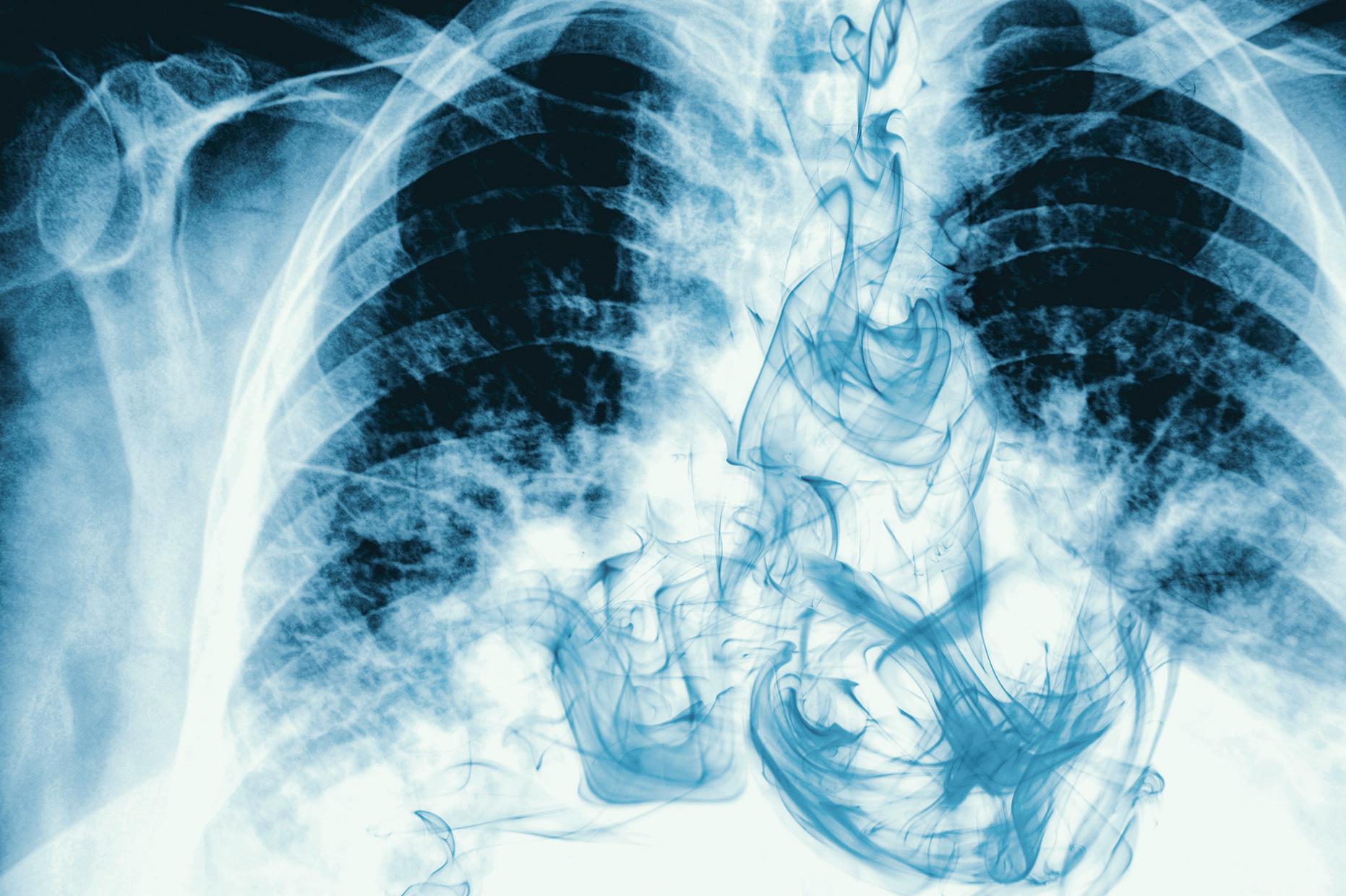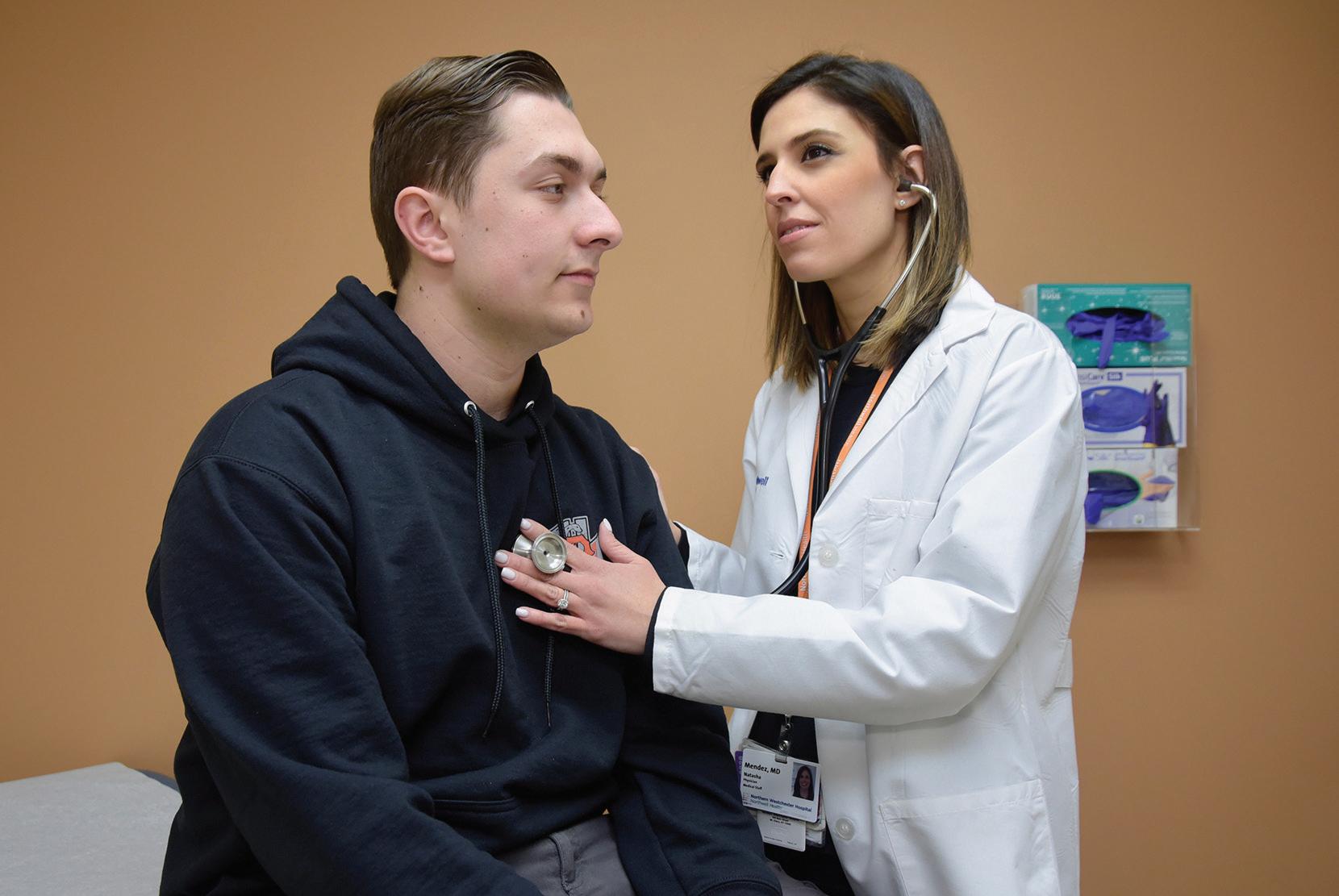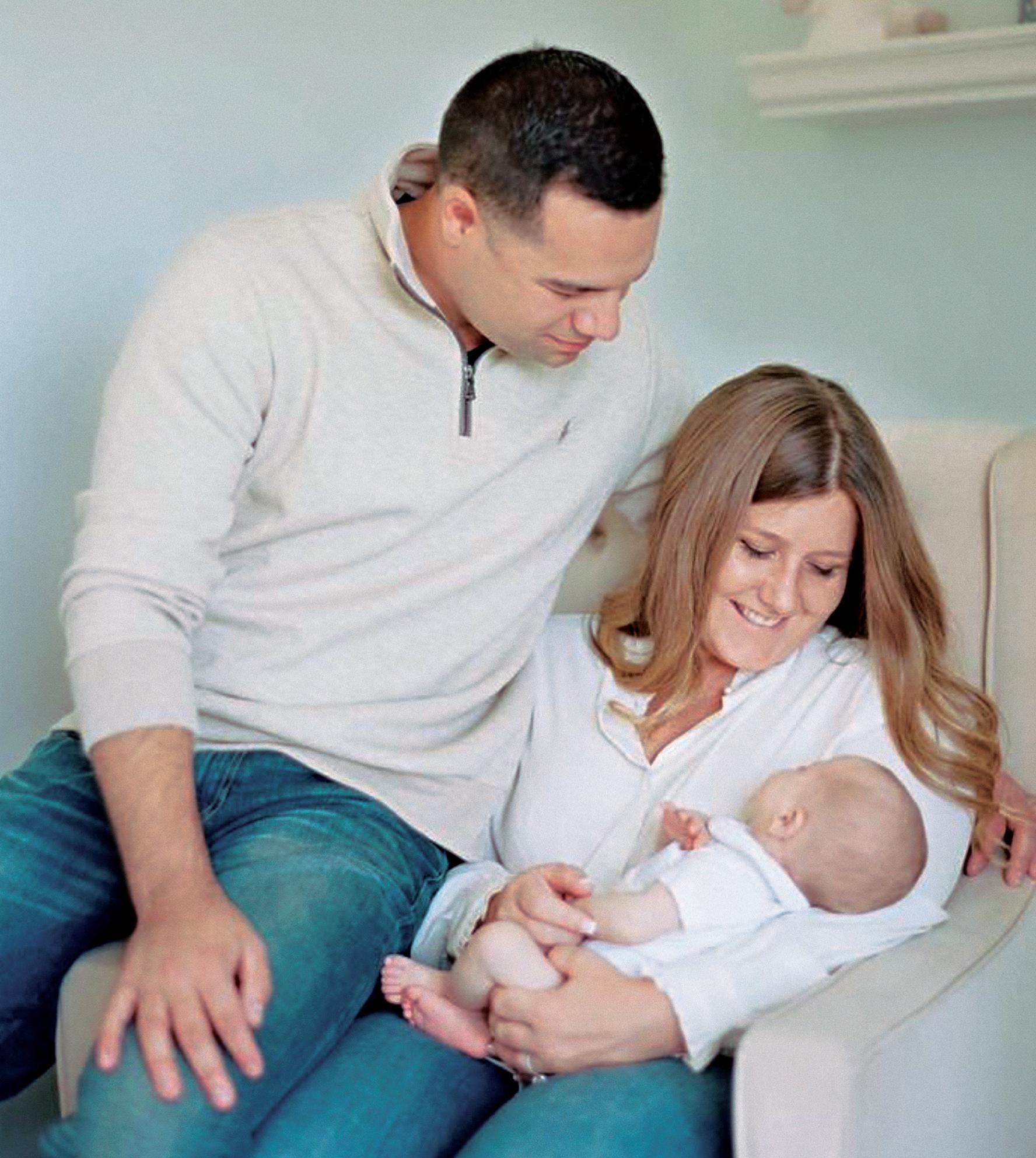
15 minute read
Acknowledge what you can control
What You Need to Know About Lifesaving Lung Cancer Screening
Lung cancer is a silent killer. In its early stages, it has no symptoms and can spread without warning. That’s why lung cancer screening for people who are high-risk is so important: They often feel perfectly healthy. “Often, people don’t develop symptoms until the disease has either spread or grown too large to cure,” notes Dr. Darren I. Rohan, Westchester Regional Director of the Thoracic Surgery Program at Northern Westchester Hospital (NWH). “That’s why it’s critical that those at high-risk are screened.”
Anyone who currently smokes or has a long history of smoking may be considered highrisk, and should speak with their doctor about the need to be screened. “If you’re between the ages of 55 and 77 and have smoked a pack of cigarettes a day for thirty years and are still smoking, or have quit within the last fifteen years, you’re considered high-risk – even if you feel fine,” Dr. Rohan says. “Also, be sure to speak to your doctor if you have more advanced symptoms, like a chronic cough, pneumonia, bloody sputum, unexplained weight loss, or chest pain.”
Although lung cancer kills more people in the United States than does any other cancer, screening saves lives. Research shows that if a person’s lung cancer is detected at an earlier stage, their five-year survival rate can increase from four percent to fifty-five percent, according to the American Lung Association.
Patients are screened with a noninvasive lowdose CT scan, which only takes a minute. Says Dr. Rohan, “It’s a very sensitive test for diagnosing lung cancer. If we see something that’s concerning, we’ll do a needle biopsy or a bronchoscopy, which
is done by inserting a thin tube down the throat and into the lungs. If it’s cancer, we’ll do a positron emission tomography, or PET scan, to determine whether it’s in an early stage or if it’s a more advanced cancer.”
If the cancer is in the early stages, the most advanced treatment option is minimally invasive robotic surgery. “The da Vinci robot enables me to move surgical instruments more precisely, protecting the surrounding healthy tissue. In addition, I’m able to make tiny incisions, so there’s less bleeding and pain for the patient. Recovery from robotic surgery takes two to three weeks, compared with six to eight weeks with traditional open surgery.”
NWH also offers advanced ablation techniques, which use image guidance to insert a needle through the skin into the tumor. Other options include burning or freezing the tumor; or stereotactic radiosurgery, which uses radiation without an incision.
“Treatment depends on the patient – what he or she feels most comfortable with. Some patients have advanced lung disease, very bad emphysema, or heart disease, and surgery is too risky.” If the patient is too high-risk, the cancer is too advanced or the patient doesn’t want surgery, an option is immunotherapy, a newer treatment.
“Immunotherapy is a targeted treatment that revs up the immune system so it’s better able to fight the cancer,” explains Dr. Rohan. It’s been remarkably effective. I have patients who are in complete remission. It’s a wonderful advancement in the treatment of lung cancer.”
Immunotherapy isn’t the only way that NWH is advancing its cancer care. “We have top-rated cancer specialists, state-of-the-art technology, leading-edge clinical trials and a full range of support programs. Our patients also have access to the leading minds in cancer across the entire Northwell Health System. Patients who want the most advanced cancer care don’t need to travel to New York City.” Are non-smokers or marijuana smokers at risk? “Even if you smoked a little, you’re at a higher risk than those who never smoked at all.” Additionally, while researchers still don’t know the precise risks for long-term marijuana smokers, Dr. Rohan points out that the habit must be taken into consideration. “We do know the risk of lung cancer is elevated. Any type of inhalation is not a good thing.”
Similarly, Dr. Rohan suspects vaping will also elevate risk, but says that researchers don’t yet have the long-term data to pinpoint by how much.
Of course, even lifetime non-smokers sometimes get lung cancer. Exposure to second-hand smoke, asbestos, or a family history of lung cancer can all increase risk. For the safest approach, speak to your doctor about any of the above risk factors. If your physician recommends a lung cancer screening, don’t delay.
Find out if lung cancer screening is right for you, call 1 (833) 586-4727.
FREE Smoking Cessation Program at NWH
We work with you until you succeed. Together, we create an individualized plan to help you quit smoking/vaping once and for all. This effective program includes weekly group meetings; proven strategies for behavior modification; nicotine replacement therapies as needed; plus caring one-on-one support.
No matter how long you’ve smoked, no matter how many times you’ve quit and started again, no matter the stresses in your life, our stateof-the-art program can set you free from nicotine’s hold. Many participants are cigarette-free for years. What’s more, you continue benefiting from the program’s support as long as you need it, even for years. Call now. The sooner you quit, the greater your body’s ability to heal. You can do it. And it’s FREE.
Quit smoking today. Call (914) 666-1868 to register for our Smoking Cessation Program.
Pediatric Specialties at Chappaqua Crossing
As a proud member of Northwell Health, we’ve been able to expand our ability to bring top-rated pediatric specialists, state-of-the-art technology, and a full range of support programs to Westchester, so that our smallest community members can get the best care right near home. It’s our mission for every child in our care to grow up happy, healthy and fit. Check out our wide range of pediatric specialties available at our Chappaqua Crossing campus at 480 North Bedford Road, Chappaqua.

Pediatric Endocrinology Dr. Joann Dimartino-Nardi Every child is unique and children don’t all develop in the same way. If you’re concerned that your child may not be developing or starting puberty, we’re here to help. We’ll help improve the overall quality of health and well-being of your child. To learn more, call (914) 458-8800.
Pediatric Cardiology Dr. Diane Kerstein & Dr. David Crowe We care for children of all ages with cardiac issues ranging from complex congenital heart disease to complaints of palpitations, chest pain, and syncope. We evaluate and treat cardiac issues that arise during pregnancy or are present in infancy, childhood, and beyond. To learn more, call (914) 458-8751.
Pediatric Weight Management Dr. Nadia Saldanha If your child is struggling with weight issues, they are not alone. In fact, more than one third of children and adolescents in the U.S. are overweight or obese. Being obese puts children and adolescents at a higher risk for chronic health problems, including cardiovascular disease, diabetes, bone and joint problems, sleep apnea, and social and psychological problems. We take a clinical, evidence-based approach to weight management. Together, we’ll work on lifestyle changes that help set children and adolescents up for long term success. To learn more, call (914) 458-8796.
Pediatric Rheumatology Dr. Katherine Steigerwald Our pediatric rheumatologist is an expert at caring for children with rheumatic disorders of the immune system. If your child is complaining of pain in the joints, muscles, bones, or tendons, or is exhibiting symptoms of arthritis or an autoimmune disorder, your pediatrician may recommend a pediatric rheumatologist. We provide the unique developmental, educational and nutritional care that your child needs. To learn more, call (914) 458-8812.
Pediatric Surgery Dr. Whitney McBride We understand the unique surgical challenges that come with treating our tiniest patients. We’re dedicated to bringing you peace of mind as we provide your children exceptional care that includes compassion, technical excellence and state-of-the-art surgical methods. To schedule an appointment, please call (914) 458-8812.


Pediatric Gastroenterology Dr. Natasha Mendez We offer the most advanced diagnostic and therapeutic techniques to diagnose and treat pediatric gastrointestinal and nutritional disorders. As we work to help your child feel better, we’ll also partner with you to help you better understand the ins and outs of your child’s recovery. To learn more, call (914) 458-8796.
Pediatric Rehabilitation Our pediatric physical and occupational therapists provide comprehensive rehabilitation services to your children from preemies to teens. We specialize in treating patients with neurologic and orthopedic conditions, neuromuscular delays, concussions and sports injuries. We’ll work collaboratively with your child’s pediatricians, physiatrists, teachers and other clinicians. To learn more, call (914) 458-8763.
5 Things I Was SO Happy to Have When I Gave Birth at NWH By Hannah R., patient at NWH
My birth plan was simple. I expected to have a natural birth in the hospital with which my doctor was affiliated, without any real complications. After all, my pregnancy had been smooth. I was healthy, worked out five times a week, and hadn’t experienced any unexpected symptoms or concerns. But if there’s one thing I learned from my pregnancy experience, it’s that childbirth is unpredictable.
When I reached a week past my due date, a surprising reality hit me: I was most likely going to be induced. Now I started to grow concerned: What if there are complications during delivery? How can I get the best possible care for my baby? How can I make sure I am there for my child every step of the way?

That’s how I found myself contemplating something that was definitely not in my birth plan: switching hospitals at 41 weeks pregnant.
As I faced induction, and the possibility of a cesarean section, it became increasingly important for me to be in a place where my baby and I could receive the best care should we need it. For me, that meant giving birth in a facility with a Level III NICU – a facility capable of caring for high-risk infants. A friend recommended Northern Westchester Hospital (NWH), and I reached out to Lorraine Owens, Mother-Baby Navigator for the labor and delivery team. Lorraine walked me through the induction process and gave me a tour of the hospital. challenging—process, the peace offered by a private room helped to ease my nerves and make the transition into parenthood as smooth as possible. The room was so relaxing, in fact, that my husband and I often joked that we felt like we were staying at a hotel instead of a hospital! 4. Boarding with baby I appreciated the options of having Henry stay in the room with us or be cared for in the nursery. Since I planned to breastfeed, I preferred my son to stay in the room. I also wanted him there so he could receive all the benefits of skin-to-skin contact, which is so important in those early days after birth. That said, it meant a lot to me to know that, if I were to experience any complications with my own recovery, he could go to the nursery and receive excellent care there as well. Fortunately, we were able to keep our son in the room with us, and the nurses repeatedly checked in to make sure we were all doing well. 5. Friendly faces all around Perhaps the best part of my experience at NWH was the great care I received from the nursing staff. Not only did they do all they could to put me at ease and tend to me and Henry, but they also helped my husband. After almost 12 hours of labor and delivery, I was so exhausted that I fell asleep shortly after our son was born. Left alone to care for our hours-old infant, my husband was understandably nervous. The nurses continually checked on him and helped him adapt to his first Daddy moments. They showed my husband how to change our baby’s diapers, and, later, how to assist with breastfeeding and rock Henry to sleep. As we cared for our newborn, the nurses made sure my husband and I didn’t forget to care for ourselves as well, reminding us to eat, rest, and stay hydrated. We couldn’t have asked for better care as we adjusted to our first days as a new and happily growing family.
In the process, Lorraine introduced me to several things I hadn’t thought about, but which made all the difference in my childbirth experience:
1. A level III NICU When my doctor began talking to me about induction, I was scared. However, knowing that I was at a facility with a state-of-the-art Level III NICU, the highest level NICU a community hospital can offer, gave me a sense of comfort as I faced the unknown. I knew that whatever happened, my baby would have access to board-certified neonatologists and highly trained nurses who could provide 24-hour care if needed. It was also meaningful to me that, should my baby require medical assistance, my husband and I could be right by my baby’s side every step of the way.
2. A guiding hand Before contacting Northern Westchester Hospital, I had never heard of a Mother-Baby Navigator. I had no idea how much support Lorraine would provide. She prepared me for admission, delivery, and bringing little Henry home. She explained everything, from how my induction would work, and the security procedures the hospital uses to keep infants safe to the Hospital’s newborn classes and all the other resources available to us for support after going home. After meeting with Lorraine, I went from feeling frightened about my potential induction to feeling informed about the process. I began to relax and focus on the excitement of meeting my baby boy.
3. A private affair Having a private hospital room gave my family time to bond after birth. I found this privacy especially important during breastfeeding. For a firsttime mother, nursing can be difficult, and I appreciated the space to focus on feeding Henry. As my son and I adjusted to this new—and sometimes

Enjoy Spring’s Bounty with these Fuss-Free Meals! Jacqueline G. Horne, RD, CDN, Clinical Registered Dietitian Northern Westchester Hospital
HOORAY! After many long months, the first seasonal crop you can buy locally is available right now at your market or farm stand. You’re no longer limited to fruits and vegetables transported from Mexico and California.
That’s a big deal for you and your family. Local foods often retain more nutrients than foods that travel long distances to reach you, which are frequently picked before they’re ripe. Consider: Broccoli picked and eaten during its natural growing season contains double the vitamin C. So visit the farm markets already opening up and check out the “local” section of your supermarket and hey, maybe visit a nearby farm or two.
Eating local is easier than you may think! Your family gets all the benefits – vibrant taste, no external ripening agent, often higher levels of nutrients – from food grown within 100 miles from the point of sale or consumption.
Here’s a taste of spring-fresh stars and great ways to cook them:
✔ While RAMPS look like small scallions, they deliver a garlicky-onion kick. Add finely sliced raw to salads; grill, roast or sauté as a side dish; use them to add flavor to polenta, scrambled eggs, soups and stir-fries.
✔ FAVA BEANS’ nutty taste and buttery texture pairs with thyme and garlic as a perfect accompaniment to simple roast chicken. High in protein and heart-healthy folate, they’re loaded with soluble fiber that helps lower cholesterol and aids digestion.
✔ High in vitamin K that supports bone health and blood clotting, ASPARAGUS is great in stir-fries and salad. Fold into cooked couscous with parsley, lemon and tomato. Yum!
✔ Add fresh-picked tummy-soothing MINT to Greek yogurt with berries. (Maybe early summer’s tiny, intensely flavorful strawberries.)
✔ Early-spring MOREL MUSHROOMS add a rich smoky meatiness to sauce. Great with milder-tasting meats like pork.
✔ Turn spring PEAS into luscious split pea soup. Peas are high in protein and in antioxidants good for the immune system.
Cream of Asparagus Soup Recipe courtesy of Skinny Taste Ingredients 2 lbs asparagus, 2 bunches, tough ends snapped off 1 Tbsp unsalted butter 1 medium onion, chopped 6 cups reduced sodium chicken broth 2 Tbsp low fat sour cream Kosher salt and fresh pepper, to taste
Nutrition Facts Serves 6 Serving size: 1¼ cups Calories 81 Carbohydrates: 10 g Protein: 6 g Fat: 3 g Sodium: 576 mg Fiber: 4 g


Directions 1. In large pot, melt butter over low heat. 2. Add onion, sauté until soft, about 2 min. 3. Cut asparagus in half and add to pot with chicken broth and black pepper. 4. Bring to boil, cover, cook low about 20 minutes or until asparagus is very tender. 5. Remove from heat, add sour cream; using hand-held blender, puree until smooth.
Strawberry Rhubarb Crunch Recipe courtesy All Recipes
Ingredients 4 cups chopped fresh rhubarb 1 pint strawberries, hulled and sliced 1 Tbsp honey 1 cup rolled oats ½ cup packed brown sugar ¼ cup butter 1 tsp ground cinnamon
Directions 1. Preheat oven to 350 degrees F. 2. In medium bowl, stir together rhubarb, strawberries, honey. 3. Transfer to shallow baking dish. 4. Stir together oats, brown sugar, and cinnamon. 5. Mix in butter until crumbly. 6. Spread over top of fruit and bake for 40 mins.


Nutrition Facts Serves 18 Serving size: 2x2 square Calories 236 Carbohydrates: 38.6 g Protein: 3 g Fiber: 4.2 g Sodium: 64 mg Fat: 8.9 g






